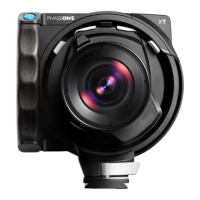Taking Advantage
of Shift movements
The XT Camera System provides horizontal as well as vertical (rise/fall)
movements that enables perspective control, image displacement and
stitching of multiple captures. The workflow is greatly improved by that fact
that any movement is automatically detected and recorded as metadata in
each image file for advanced and seamless Lens Cast Correction (LCC) in
Capture One.
The integrated Shift feature allows you the take advantage of the large image
circle provided by certain lenses in the XT Camera System by shifting its
optical center compared the sensor’s position. The XT Camera can be shifted
up to 12mm left or right as well as accepting a 12mm rise or fall.
Note that since the tripod foot is mounted to the XT Lens/Camera and not the
IQ4, it is in eect the sensor that is being shifted against the image circle.
Using Shift on the XT Camera
The horizontal and vertical (rise/fall) movements is operated by Horizontal
Shift Dial on the top of the XT Camera Body and the Vertical Shift Dial
located at the right-hand side of the camera.
You can check the amount of X movements in millimeters at the top of the
camera body with the Horizontal Shift Scale and amount of Y movements in
millimeters at the side of the camera body with the Vertical Shift Scale. The
dials have incremental steps to provide a tactile response when adjusting them
and you can apply shift the XT Camera in both directions up to +/- 12mm.
The shifted scale will also be visible on the IQ4 when using Live View and the
Camera Controls screen and will – as mentioned – be recorded automatically
in the captured image metadata. The illustration below clarifies how a
horizontal (X) or vertical (Y) shift is recorded with a positive (+) or negative (-)
value.
Horizontal Shift Dial
Vertical Shift Dial
48Taking Advantage of ShiftXT Camera System Manual |

